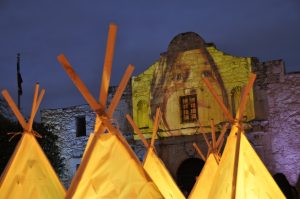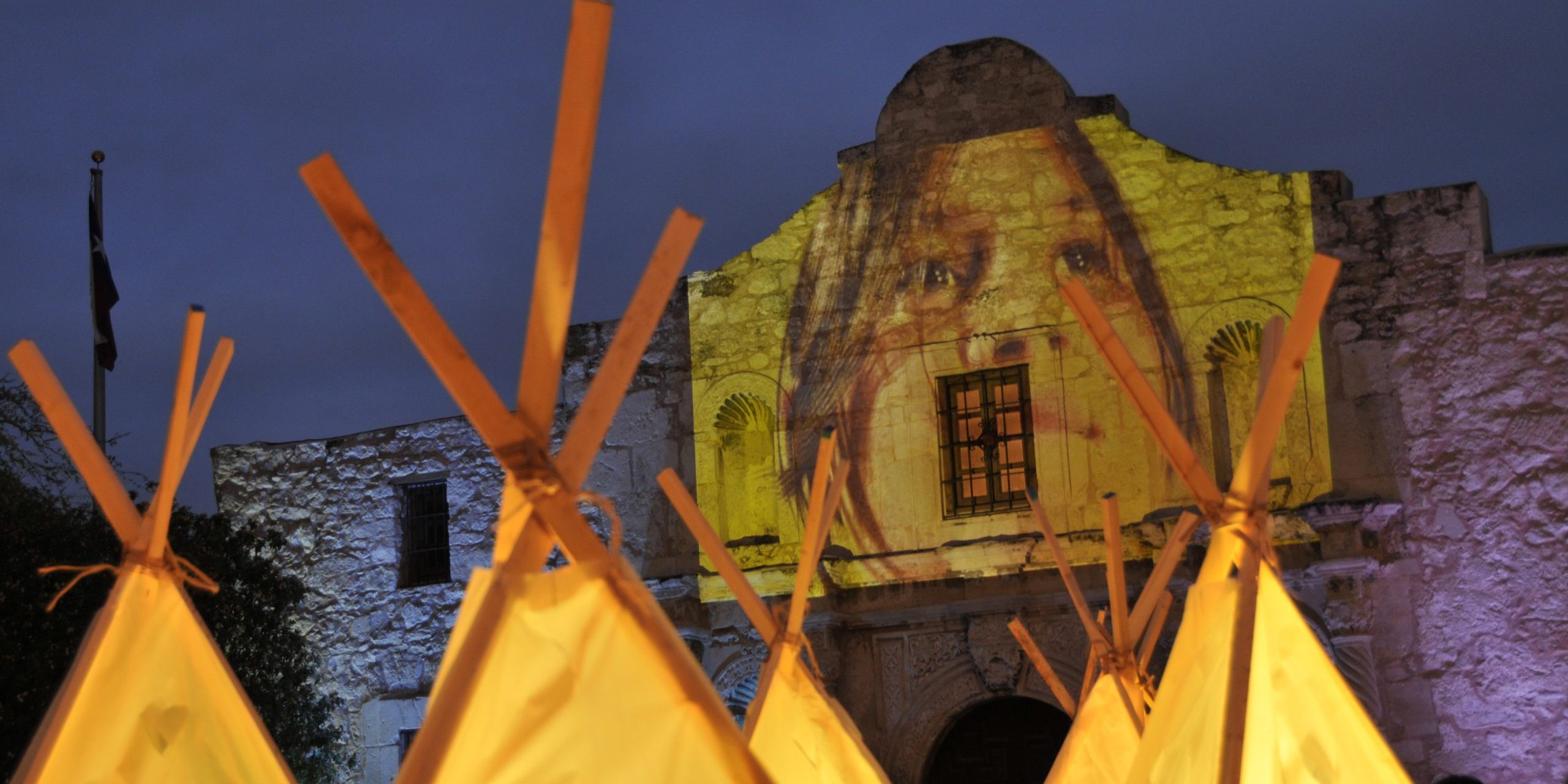Originally posted on the Xica Media Page.
The Alamo is a place of ancestral memory where native residents are descendants of the indigenous population that have inhabited San Antonio or Yanaguana for over 10,000 years. The rewriting of Texas history has been one in which the colonial settler narrative attempted to exclude their contribution and existence to the city and state. The Alamo Redesign, a 4.5 million dollar project, brought to light a realization that if they continued to recognize the cemetery- the laws regarding grave sites and cemeteries would jeopardize their project. The Tap Pilam Coahuiltecan Nation sued the Alamo Trust, the state land office and other groups involved in the renovation in September, because they had not been able to protect the ancestral remains buried at the site and were excluded from advising on the restoration. This fight is ongoing. When the installation was created , the Alamo , was a much coveted spot for Luminaria Arts night in San Antonio. Never before had an indigenous or Chicana artist created sight specific art on the grounds. When Vaago Weiland joined the project the artistic and historical nature of the collaboration became one of legends as they navigated bureaucratic and long standing Texas power structures to create Enlight-Tents.
Last fall the long awaited publication Latina Outsiders Remaking Latina, edited by Grisel Y. Acosta was released. The chapter Haciendo Caras features the work of Xica Media’s Laura Varela. The following interview took place between Xica Media and Dr. Cathryn Merla Watson.

Laura Varela’s Enlight Tents
Xica Media: Tell us about the book.
Dr. Cathryn Merla-Watson: Latina Outsiders Remaking Latina Identity is a collected works that compiles original creative works, including short fiction, poetry, testimonios, and visual art, as well as scholarly essays that explore and redefine what it means to be a Latina and an outsider in our current moment.
The inclusion of creative works is so important because it pushes back against the idea that “real” scholarship only takes form as an academic essay. It’s also super innovative in that it explores not only what it means to be a Latina in mainstream culture, but also an “outsider” among other Latinas or in your own community–a subject that is not often explored. For example, there is a section “Gender/Sexuality” that explores queer Latina identity as well as a section “Disability” that focalizes the diverse experiences of disabled Latinas. What is also really wonderful about this book is that it is modeled after foundational women of color feminist collected works like This Bridge Called My Back: Writings by Radical Women of Color (1981) and its follow-up This Bridge We Call Home: Radical Visions for Transformation (2002), which bridge the diverse experiences of Latinas and women of color, fostering solidarity and understanding. Latina Outsiders was edited by Dr. Grisel Y. Acosta who earned her Ph.D. in literature at UTSA and is currently an associate professor at the City University of New York – Bronx Community College. You can purchase the book from Amazon here, or on the publisher’s website.
XM: Can you tell me a little about your chapter? As a San Antonio Native, why was this subject important?
CMW: My chapter “Haciendo Caras: The Alter-Native Illuminations of Laura Varela and Vaago Weiland’s Enlight-Tent” focuses on site-specific mixed-media installation set up in Alamo Plaza at San Antonio’s contemporary arts festival Luminaria in 2009. Alamo plaza is a site of multiple historical traumas and the grounds of the Alamo, what anthropologist Richard Flores calls a “master symbol” of white supremacy. This site is literally a palimpsest where indigenous life ways and identity–as well as Chicana/o/x identity–has been violently erased, disappeared. Using Gloria Anazaldúa’s concept of “haciendo caras” or “making face,” I discuss how this brilliant installation composed of illuminated tents and large-scale projections of brown faces onto the facade of the Alamo “makes face” or rewrites history, makes visible the pasts and presents of indigenous and Chicana/o/x peoples in the “Mission City.”
Watch documentation film here:
San Antonio writer John Phillip Santos has called San Antonio a “city of forgetting.” As a mixed race Chicana, I was certainly never taught my history until graduate school at UTSA. Our history is whitewashed–especially by the built environment. The Alamo is part of a larger constellation of missions–in fact, the largest constellation of missions in North America! Yet, we forget what these missions stand for–the violent inculcation of white Spanish knowledge and ways of being and the erasure of indigenous cultures. This history is naturalized and whitewashed within the current landscape. Also, I had been wanting to write about Varela’s work for quite some time, which I feel does not get the recognition it deserves. I feel this way about many of the Chicana cultural workers in San Antonio and beyond. This installation was really pioneering and managed to be intellectually sophisticated yet accessible to a broad audience at the same time. I also hope that this essay helps to archive her vitally important work.
XM: Can you tell us about yourself; your publications research, scholarship and biking?
CMW: I am originally from San Antonio; in fact, like many Mexican Americans in SA, my great-grandparents immigrated from northern Mexico in the early 20th-century and settled on the Westside. I have deep roots here and they inspire my research. I earned my MA in literature from UTSA and earned a Ph.D. in American Studies from the University of Minnesota. I am currently the Co-Director of Gender and Women’s Studies and an Assistant Professor in Mexican American Studies at UT-Río Grande Valley.
I have researched and published on a broad range of topics pertaining to Chicana/o/x aesthetics, such as the theories of Gloria Anzaldúa, the poetry of Lorna Dee Cervantes, or the visual art of Luis Valderas (also from SA!). I co-edited with Ben Olguín the collected works Altermundos: [email protected] Speculative Literature, Film, and Popular Culture (2017) which won the American Book Award in 2018. It is the first collected works dedicated to theorizing the Latina/o/x speculative arts, and includes several San Antonio writers and artists. I am currently working on two projects. The first is a book that explores how queer Chicana performances repurpose the post/apocalyptic to redefine the “world-ending,” and the second is a collaborative project theorizing the Latina/o/x Gothic. Both projects use speculative genres to re-read the sometimes horrific or apocalyptic lived experiences of Latina/o/xs.
I am also a competitive cyclist and I have competed at the pro/elite levels. Since moving down to the Río Grande Valley and co-founded the first-ever women’s bike racing team down here–Corazón Racing. We are also unique in that we are mainly a Latina team (the sport of cycling is pretty lily white). We range from the age of 13 to 61. Our women have done really well the past few years at regional races–which are quite tough! Texas women bike racers are beasts! But overall, women who bike race in Texas are not only athletically gifted (seriously, some have gone on to top professional teams) but also fierce and feminist, insanely smart, as well as incredibly supportive and kind.
XM: How does life in the RGV /front lines impact your work your teaching?
CMW: In so many ways. To put it in perspective, I live in Mission and less than 5 miles from the border and Anzaldúa’s International Bridge (yes, same family as Gloria Anzaldúa!). I’m near the border (where they’re building the wall) quite a bit since I cycle over there, and I see undocumented immigrants being detained all the time. It’s heartbreaking–and enraging. The right-wing media makes it seem as though “hoards” of immigrants are trying to storm our borders, and that’s not the case. Also, people who cross this way are the most desperate of the desperate, poorest of the poor. Our immigration policies and laws are inhumane.
But these issues shape the daily realities of the students I teach. Most of my students are Mexican or Chicana/o/x and first generation. Many of them are poor or working class. Many of them have parents, family, or friends who are undocumented. So many of my students struggle. I try to teach them material that builds on their experiences and valorizes their identities.
This region also inspires my research, which in turn makes my research relevant to the undergraduates and graduate students I teach and mentor. Like I said previously, I am really interested in defining gothic horror from the perspective of Latina/o/xs. What is more horrific than our immigration policies (especially now with the onslaught of covid-19)? Or Mexican lynchings in south Texas in the early 20th-century? I could go on… But, I also want to underline that there is so much beauty in the RGV too that inspires me, both in the vibrant culture and community down here as well as the natural environment (it’s like desert meets the tropics). Not to sound cliche, but living and teaching down here I often think of Gloria Anzaldúa’s poetic description of the borderlands being “una herida abierta where the Third World grates against the first and bleeds.” It’s a space of pain but it is also generative and beautiful.
c/s








